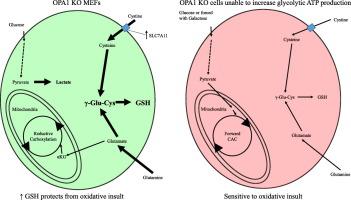Biochimica et Biophysica Acta (BBA) - Molecular Cell Research ( IF 4.6 ) Pub Date : 2020-09-11 , DOI: 10.1016/j.bbamcr.2020.118854 David A Patten 1 , Shawn McGuirk 2 , Ujval Anilkumar 3 , Ghadi Antoun 4 , Karan Gandhi 4 , Gaganvir Parmar 5 , Mohamed Ariff Iqbal 3 , Jacob Wong 3 , Richard B Richardson 6 , Julie St-Pierre 7 , Ruth S Slack 3 , Mary-Ellen Harper 5

|
Mitochondria are highly dynamic organelles. Alterations in mitochondrial dynamics are causal or are linked to numerous neurodegenerative, neuromuscular, and metabolic diseases. It is generally thought that cells with altered mitochondrial structure are prone to mitochondrial dysfunction, increased reactive oxygen species generation and widespread oxidative damage. The objective of the current study was to investigate the relationship between mitochondrial dynamics and the master cellular antioxidant, glutathione (GSH). We reveal that mouse embryonic fibroblasts (MEFs) lacking the mitochondrial fusion machinery display elevated levels of GSH, which limits oxidative damage. Moreover, targeted metabolomics and 13C isotopic labeling experiments demonstrate that cells lacking the inner membrane fusion GTPase OPA1 undergo widespread metabolic remodeling altering the balance of citric acid cycle intermediates and ultimately favoring GSH synthesis. Interestingly, the GSH precursor and antioxidant n-acetylcysteine did not increase GSH levels in OPA1 KO cells, suggesting that cysteine is not limiting for GSH production in this context. Post-mitotic neurons were unable to increase GSH production in the absence of OPA1. Finally, the ability to use glycolysis for ATP production was a requirement for GSH accumulation following OPA1 deletion. Thus, our results demonstrate a novel role for mitochondrial fusion in the regulation of GSH synthesis, and suggest that cysteine availability is not limiting for GSH synthesis in conditions of mitochondrial fragmentation. These findings provide a possible explanation for the heightened sensitivity of certain cell types to alterations in mitochondrial dynamics.
中文翻译:

线粒体融合的改变驱动了能够转换为糖酵解ATP产生的细胞中的防御性谷胱甘肽合成。
线粒体是高度动态的细胞器。线粒体动力学的变化是因果关系,或与许多神经退行性疾病,神经肌肉疾病和代谢性疾病有关。通常认为具有改变的线粒体结构的细胞易于发生线粒体功能障碍,增加活性氧的产生和广泛的氧化损伤。当前研究的目的是研究线粒体动力学与细胞抗氧化剂谷胱甘肽(GSH)之间的关系。我们发现缺少线粒体融合机制的小鼠胚胎成纤维细胞(MEF)显示出高水平的GSH,这限制了氧化损伤。此外,靶向代谢组学和13C同位素标记实验表明,缺乏内膜融合GTPase OPA1的细胞会发生广泛的代谢重塑,从而改变柠檬酸循环中间体的平衡,并最终促进GSH的合成。有趣的是,GSH前体和抗氧化剂ñ-乙酰半胱氨酸不会增加OPA1 KO细胞中GSH的水平,这表明在这种情况下半胱氨酸对GSH的产生没有限制。有丝分裂后神经元在没有OPA1的情况下无法增加GSH的产生。最后,使用糖酵解产生ATP的能力是OPA1缺失后GSH积累的必要条件。因此,我们的结果证明了线粒体融合在调节GSH合成中的新作用,并表明在线粒体片段化的条件下,半胱氨酸的可用性并不限制GSH合成。这些发现为某些细胞类型对线粒体动力学变化的敏感性增强提供了可能的解释。











































 京公网安备 11010802027423号
京公网安备 11010802027423号